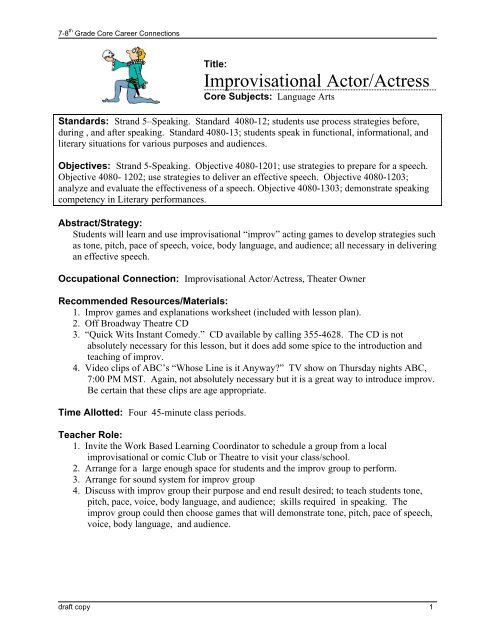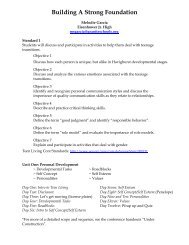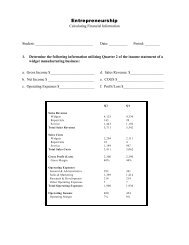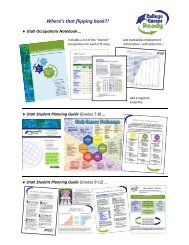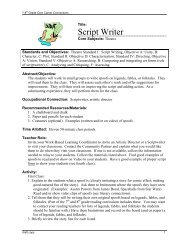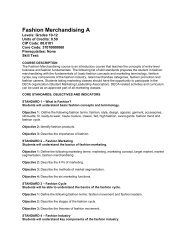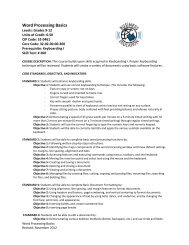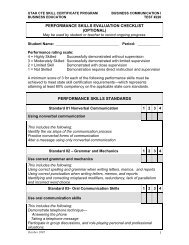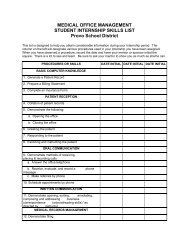Improvisational Actor/Actress
Improvisational Actor/Actress
Improvisational Actor/Actress
Create successful ePaper yourself
Turn your PDF publications into a flip-book with our unique Google optimized e-Paper software.
7-8 th Grade Core Career Connections<br />
Title:<br />
<strong>Improvisational</strong> <strong>Actor</strong>/<strong>Actress</strong><br />
Core Subjects: Language Arts<br />
Standards: Strand 5–Speaking. Standard 4080-12; students use process strategies before,<br />
during , and after speaking. Standard 4080-13; students speak in functional, informational, and<br />
literary situations for various purposes and audiences.<br />
Objectives: Strand 5-Speaking. Objective 4080-1201; use strategies to prepare for a speech.<br />
Objective 4080- 1202; use strategies to deliver an effective speech. Objective 4080-1203;<br />
analyze and evaluate the effectiveness of a speech. Objective 4080-1303; demonstrate speaking<br />
competency in Literary performances.<br />
Abstract/Strategy:<br />
Students will learn and use improvisational “improv” acting games to develop strategies such<br />
as tone, pitch, pace of speech, voice, body language, and audience; all necessary in delivering<br />
an effective speech.<br />
Occupational Connection: <strong>Improvisational</strong> <strong>Actor</strong>/<strong>Actress</strong>, Theater Owner<br />
Recommended Resources/Materials:<br />
1. Improv games and explanations worksheet (included with lesson plan).<br />
2. Off Broadway Theatre CD<br />
3. “Quick Wits Instant Comedy.” CD available by calling 355-4628. The CD is not<br />
absolutely necessary for this lesson, but it does add some spice to the introduction and<br />
teaching of improv.<br />
4. Video clips of ABC’s “Whose Line is it Anyway?” TV show on Thursday nights ABC,<br />
7:00 PM MST. Again, not absolutely necessary but it is a great way to introduce improv.<br />
Be certain that these clips are age appropriate.<br />
Time Allotted: Four 45-minute class periods.<br />
Teacher Role:<br />
1. Invite the Work Based Learning Coordinator to schedule a group from a local<br />
improvisational or comic Club or Theatre to visit your class/school.<br />
2. Arrange for a large enough space for students and the improv group to perform.<br />
3. Arrange for sound system for improv group<br />
4. Discuss with improv group their purpose and end result desired; to teach students tone,<br />
pitch, pace, voice, body language, and audience; skills required in speaking. The<br />
improv group could then choose games that will demonstrate tone, pitch, pace of speech,<br />
voice, body language, and audience.<br />
draft copy 1
7-8 th Grade Core Career Connections<br />
5. Students in 8 th grade Language Arts are required to demonstrate speaking competency.<br />
Included in that demonstration must be the use of tone, pitch, pace, voice, body language,<br />
and audience.<br />
6. The use of improv games will help students to learn these speech conventions. The<br />
desired aim of this activity is to transfer skills learned and gained in improv games to<br />
students public speaking.<br />
Pre-Activity:<br />
1. As an introduction to speech skills use Houghton Mifflin Writer’s Inc., A Student<br />
Handbook for Writing and Learning. Sections 514-543 explain the process of preparing<br />
and presenting a speech.<br />
2. Show clips of “Whose Line is it Anyway?”–be certain that these clips are age appropriate.<br />
Not absolutely necessary to lesson plan, just some fun.<br />
3. Play numbers 11 and 13 from the CD from Off Broadway Theatre “Quick Wits.” Again,<br />
not absolutely necessary to lesson plan. Address to obtain CD is included with lesson<br />
plan.<br />
4. Improv group to perform and explain games and how these games would relate to public<br />
speaking. Some specific games to play to teach tone, pitch, pace, voice, body language,<br />
and audience would be Accents, Action Figures, Emotions, and Faces. Other games may<br />
be selected by the improv group to demonstrate these skills.<br />
5. If the improv group cannot visit school the Language Arts teacher, perhaps in conjunction<br />
with the Drama teacher, could easily explain and demonstrate these games. The Drama<br />
classes might want to learn these games and perform for the 8 th grade students if the<br />
improv group could not visit the school. A copy of the games is included with lesson<br />
plan.<br />
Activity:<br />
1. Break class into groups of 2-3 to practice the improv games modeled.<br />
2. Each group performs for class one improv game, game chosen by class/ teacher. Again be<br />
certain to chose games like Accents, Action Figure, Emotions, and Faces as these games<br />
may be some of the best to teach tone, pitch, pace, voice, body language, and audience.<br />
3. Ask each group after their performance to offer feedback on how they did. Discuss what<br />
they would change or how they could do better. How do these games display the<br />
conventions of tone, pitch, pace, voice, body language, and audience necessary in public<br />
speaking? How are they going to use these techniques in their literary speech, or any<br />
public speech? Also elicit feedback from peers and teacher for each group. Sample<br />
rubric included in lesson plan.<br />
Suggested Assessment:<br />
Verbal critique after each group performance as well as rubric critique of each group.<br />
Work-based Learning, Community Connection:<br />
An improvisational actress/actor from a local theatre or comedy club, whose skills would be<br />
used in demonstrating and teaching improv techniques. Community partner will visit<br />
classrooms/schools to introduce and perform improv games. .<br />
draft copy 2
7-8 th Grade Core Career Connections<br />
Literary Connection:<br />
The Young <strong>Actor</strong>s Book of Improvisation; Dramatic Situations from Shakespeare to<br />
Speilburg, ages 12-16, Sandra Caruso and Susan Kosoff, Heinemann Publisher, 1998.<br />
Theater Games for Young Performers: Improvisations and Exercises for Developing Acting<br />
Skills, Maria C. Novelly, Arthur Zapel and Kathy Pijanowski, Meriwether Publisher, 1985.<br />
Writers Inc. A Student Handbook for Writing and Learning. Houghton Mifflin Company,<br />
1996. Speaking and Thinking Sections 514 to 543. Ten out of Ten: Ten Winning Plays<br />
Selected from the Young Playwrights Festival, 1982-1991. Wendy Lamb, editor. Delacorte<br />
Press, 1992. Fiction. Break A Leg, Betsy Maybe! Lee Kingman. Wiliam Morrow/Beech<br />
Tree Books. 1993. Fiction.<br />
Internet Connection:<br />
SLCStage.com A listing of all theatres in Salt Lake Valley as well as from St. George to<br />
Logan. Great links into other sites as well. <strong>Improvisational</strong> drama.com-nation-wide site for<br />
improv materials/groups. <strong>Improvisational</strong> acting.com-nation-wide site for materials/groups.<br />
draft copy 3
7-8 th Grade Core Career Connections<br />
Group Members<br />
“Improv” Game<br />
To what extent did<br />
group:<br />
Vary tone<br />
Extensively Somewhat Minimally<br />
Vary pitch<br />
Vary pace of speech<br />
Use voice to support<br />
meaning<br />
Use body language to<br />
support meaning<br />
Adjust to audience<br />
draft copy 4
7-8 th Grade Core Career Connections<br />
Improv games and explanations<br />
(Please remember, these titles are those used by “Quick Wits” and the same game may go by another<br />
name somewhere else).<br />
A to Z – 2 player<br />
The object of this game is that each player begins his/her line with an agreed upon letter of the alphabet<br />
and then the next player begins their line with the next letter and so on. You can begin with any letter and<br />
you may also do it one word at a time as well.<br />
Accents – 2 player<br />
The object of this game is to put the players in a conversational situation like a date or shopping. They<br />
begin in regular accents and then have to change their accents as the MC calls them out. It’s good for the<br />
audience too, because they can give suggestions for the accents.<br />
Action Figures – 2 player and 2 audience member<br />
Two players are brought out onstage and they stand frozen. Two audience members are called up to stand<br />
behind the players. The players are only allowed to move as the audience members pose them. They<br />
have to carry on a scene while being posed like Barbie dolls.<br />
Between the Lines – 3 player<br />
Two of the players are given some kind of books to read from. (The easiest are scene books although we<br />
have used anything from dictionaries to fix it books)! They can only read lines from a page picked at<br />
random from their books. The person in the middle speaks normally and has to “glue” it together and<br />
they all make a scene that makes sense.<br />
Crocodile Hunter – 3 player<br />
This is a new game we have come up with based on the popular cable show. One person (with a<br />
convincing Australian accent) is the Crocodile guy and one plays his wife, Terry. They are on a mission<br />
to go into the wildlife and capture a….That’s where the third guy comes in. He plays whatever the<br />
audience says they should capture. But he isn’t an animal he is an everyday guy like a librarian or a<br />
Teacher or Doctor, etc. So the two hunters capture him and show us all in the audience how it’s done.<br />
Dating Game – 4 player<br />
Three of the players are dating game contestants and one is looking for a date. The dateless one is sent<br />
from the room and the audience chooses something crazy for the three contestants to be like drunk, an ex<br />
husband, a circus clown etc. When they have chosen, the dateless guy comes back in and must guess who<br />
they are with the dating game questions he asks.<br />
Emotions – 2 player<br />
Two players are put into an everyday occurrence like returning something to a store. They start of<br />
normally and then they must act out different emotions as the MC calls them out.<br />
draft copy 5
7-8 th Grade Core Career Connections<br />
Enter/Exit – 5 player<br />
The players are brought out to the front of the stage and the audience assigns one a color, one a number,<br />
one an animal, one a shape and one a food. One person starts the scene on stage and as the players hear<br />
their word they either enter or exit depending on where they are. The scene ends when they are all<br />
eventually off the stage.<br />
Expert Slides – 4 player<br />
Two players are the hosts of a talk show. They are experts on some kind of animal picked by the<br />
audience. The other two players are the slides. As the hosts click on a slide the two “Slide” people form<br />
a ridiculous pose and the hosts have to comment on it like they were looking at slides of the animal they<br />
are experts on. You can add things like “This is a video” or “Hey this one is in upside down!”.<br />
Faces – 4 player<br />
The players are brought on stage and the audience gives each of them an emotion such as happy or<br />
shocked and the player must make a face to go along with that emotion and hold it for the remainder of<br />
the skit. The MC chooses an every day event and the scene goes from there with everyone keeping their<br />
frozen faces and playing out the scene.<br />
Occupations – 2 player<br />
This game is similar to emotions but instead of the MC calling out different emotions he calls out<br />
different occupations. When the players hear the next occupation they freeze in whatever pose they were<br />
in for the previous one and must start the next occupation from there, the humor coming from them<br />
having to explain their way out of that certain pose.<br />
Pieces of Paper – 2 player<br />
Several pieces of paper are spread out on the ground before the 2 players. These pieces of paper have<br />
little sayings on them. They could be pre written or you could send the players out and have the audience<br />
come up with the sayings on the spot. The players are put into a scene and must each in turn read one of<br />
the papers as a line in their scene. The game is over when all of the papers have been read.<br />
Missing Shakespeare – 2 to 3 player<br />
The players are given an every day occurrence to play out like a trip to 7-11 or a camping trip and the<br />
players must play out a scene using Shakespearean dialogue and phrasing.<br />
Stand Up, Sit Down, Bend Over – 3 player<br />
The players are given a scene and someone must be standing, someone must be sitting and someone must<br />
be bent over at all times. They play out the scene and move all around, every one changing their positions<br />
every once in a while.<br />
I hope these games will get you started and if you need any more ideas or instruction, please come on<br />
down and see us in person!!<br />
Melissa Porter<br />
Off Broadway Theatre<br />
draft copy 6
7-8 th Grade Core Career Connections<br />
draft copy 7
7-8 th Grade Core Career Connections<br />
draft copy 8
7-8 th Grade Core Career Connections<br />
draft copy 9


